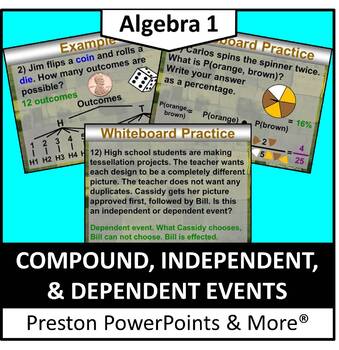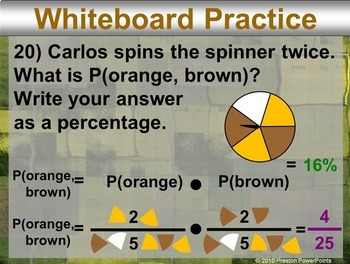Compound, Independent, & Dependent Events in a PowerPoint Presentation
- Zip
Description
Compound, Independent, & Dependent Events in a PowerPoint Presentation
This slideshow lesson is very animated with a flow-through technique. I developed the lesson for my Algebra 1 class, but it can also be used for upper level class reviews. This lesson teaches how to find the total number of outcomes from a compound event, identify if an event is independent or dependent, & find the probability of an compound event.
NEW: The lesson is in an editable format so you can tailor the lesson to your class. The problems and clipart can’t be edited due to the TOU and to maintain the copyright integrity of the product. You can change the problem number and the names. Using student’s or teacher’s names can be another hook. If you need an alternative version because your country uses different measurements, units, or slight wording adjustment for language differences just email me at PrestonPowerPoints@gmail.com. I am respond to email quickly.
The presentation has 46 slides with LOTS of whiteboard practice. Use as many or as few of the problems to help your students learn each concept. For more PowerPoint lessons & materials visit:
http://www.teacherspayteachers.com/Store/Preston-Powerpoints
Students often get lost in multi-step math problems. This PowerPoint lesson is unique because it uses a flow-through technique, guided animation, that helps to eliminate confusion and guides the student through the problem. The lesson highlights each step of the problem as the teacher is discussing it, and then animates it to the next step within the lesson. Every step of every problem is shown, even the minor or seemingly insignificant steps. A helpful color-coding technique engages the students and guides them through the problem (Green is for the answer, red for wrong or canceled numbers, & blue, purple & sometimes orange for focusing the next step or separating things.) Twice as many examples are provided, compared to a standard textbook. All lessons have a real-world example to aid the students in visualizing a practical application of the concept.
This lesson applies to the Common Core Standard:
Conditional Probability and the Rules of Probability HSS-CP.1, HSS-CP.2
Understand independence and conditional probability and use them
to interpret data.
1. Describe events as subsets of a sample space (the set of outcomes) using characteristics (or categories) of the outcomes, or as unions, intersections, or complements of other events (“or,” “and,” “not”).
2. Understand that two events A and B are independent if the probability of A and B occurring together is the product of their probabilities, and use this characterization to determine if they are independent.
This resource is for one teacher only. You may not upload this resource to the internet in any form. Additional teachers must purchase their own license. If you are a coach, principal or district interested in purchasing several licenses, please contact me for a district-wide quote at prestonpowerpoints@gmail.com. This product may not be uploaded to the internet in any form, including classroom/personal websites or network drives.
*This lesson contains 25 problems. Each problem in this lesson uses several pages in order to achieve the animated flow-through technique.





